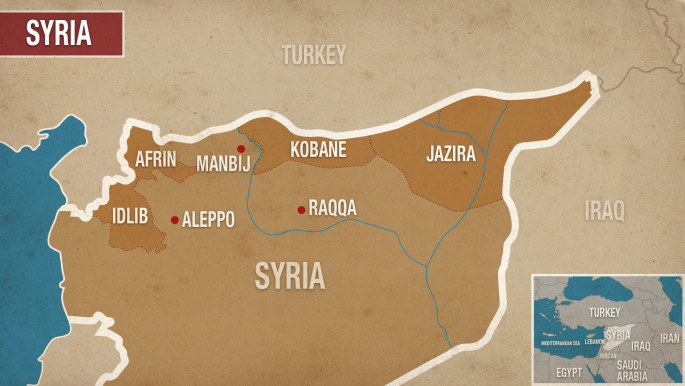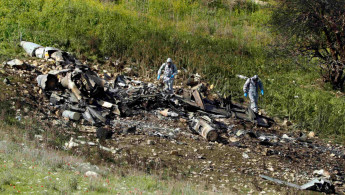Follow him on Twitter: @pauliddon
The war in Syria is entering a new phase
Over the past week, two major developments in the war in Syria signal that the war is entering a new phase in which the regime will have reconquered most of the country and will shift its focus on countering foreign forces.
The United States
On February 7, Iranian-trained militia forces fighting under the banner of the Syrian army launched an attack on US-backed Kurdish-led Syrian Democratic Forces (SDF) in Syria's eastern Deir az-Zour province.
The Americans swiftly responded with airstrikes, killing at least 100 of the attacking militia and destroying two of their tanks in "self-defence".
This wasn't the first time the US has attacked regime forces in defence of its positions in Syria. Last year it shot down Iranian-made drones, targeted pro-regime ground forces attempting to attack Al-Tanf on the Jordanian border - where the US and its coalition allies have a training base for anti-IS fighters - and also shot down a Syrian Su-22 fighter jet that targeted SDF forces near Tabqa.
This month's clash comes as the Pentagon seems set to maintain an open-ended military presence in Syria's Kurdish territories in the northeast, as the war against IS comes to a close.
 |
Whatever the American plan for Syria is, if they have one, it's clear they will retain forces there |  |
Already Washington has faced opposition from Damascus - which generally opposes a US military presence on Syrian soil - as well as Moscow, which alleges the US is attempting to partition Syria by retaining a troop presence in its Kurdish-controlled territories, and Tehran - which fears that the US presence is at least partially aimed at keeping its own growing proxy presence in Syria in check.
Turkey, a key NATO ally, has also condemned Washington's plan to train a 30,000-strong SDF force to guard the frontiers of areas they captured in the fight against IS. This has resulted in the Pentagon walking back these plans, claiming it was all just a simple misunderstanding.
Ankara has also warned the US that their troops might become targets of Turkish-backed forces if they continue to support the SDF in the Arab city of Manbij, which Turkey is once again vowing to capture.
Whatever the American plan for Syria is, if they have one, it's clear they will retain forces there, where they have built airbases and other facilities across the northeast, for some time to come. As the IS threat evaporates, this presence is likely going to become much more contentious and face increasing challenges and threats.
Read more: How long will the US stay in Syria?
Turkey
Ankara increased its involvement in Syria on January 20 by launching Operation Olive Branch against Afrin, an isolated northwest Syrian Kurdish enclave. Turkey intends to destroy the Syrian Kurdish People's Protection Units (YPG) there, which it sees as an extension of the Kurdistan Workers' Party (PKK), against which it has fought a deadly insurgency for more than 30 years.
In doing so, Ankara wants to see to it that the YPG is removed from every single area of Syrian border territory west of the Euphrates.
While Damascus has condemned the operation and vowed to shoot down Turkish jet fighters bombing Afrin - they have moved anti-aircraft weapons to their front-line positions in neighbouring Aleppo and Idlib provinces - Russia has tacitly supported Turkey, withdrawing the small force of military police it had stationed in that enclave.
Turkish leaders claimed that the operation would be a swift success. However, three weeks in and they've had only minor success, capturing a handful of Afrin's 350 villages while losing at least 31 troops and some advanced equipment - most notably some of its German-made Leopard II tanks, the presence of which in Syria has compelled Berlin to withhold important upgrades.
Ankara has even lost one of its T-129 attack helicopters - the model that saw its combat debut over Afrin and which the Turkish press highlighted as a prime example of the self-sufficiency of Turkey's growing arms industry - to Kurdish fire.
 |
| Afrin, Kobane and Jazira are all controlled by Kurdish forces, which concerns Turkey greatly |
The behaviour of Turkey's proxy militias, who fight under the banner of the Free Syrian Army (FSA), has further hurt the image of Turkey's campaign in light of their alleged mutilation of female Kurdish fighter Barin Kobani's corpse.
If Ankara hopes to achieve its objective in Afrin it will likely remain fighting there, losing troops and equipment for at least another couple of months.
In the meantime, the Syrian regime will have had time to reconquer the neighbouring province of Idlib from Hay'at Tahrir al-Sham (HTS) and be in a better position to challenge the Turkish military presence both in Afrin and other territories captured from IS in Operation Euphrates Shield between August 2016 and March 2017 - the triangle of territory expanding from Al-Bab in the south to Al-Rai on the border and across to Jarablus, also on the border on the western shores of the Euphrate River.
Damascus is already giving support to the YPG against the Turkish incursion by allowing them to reinforce their fighters through territory controlled by Assad.
Turkey has also expressed its long-term desire for northern Syria, saying it planned to resettle the 3.5 million Syrians now in Turkey. As with the US, the longer they stay following the IS defeat, and the regime's likely defeat of the remnants of the opposition, the more difficult it will become to maintain this presence.
 |
This was the first time in decades that Israel has lost one of its jet fighters in combat |  |
Israel
On February 10, an Iranian-made drone violated Israeli airspace only to be promptly shot down by an Apache gunship. Israeli jet fighters responded by bombing 12 targets in Syria, four of which belonged to Iran. On the return flight home, one of the jets, an F-16I Sufa, was lost to Syrian anti-aircraft fire.
The pilots successfully ejected and landed in Israel's north. This was the first time in decades that Israel has lost one of its jet fighters in combat.
Israel has been launching airstrikes into Syria for more than five years now, invariably targeting hi-tech "game-changing" weapons it doesn't want Hizballah to get its hands on - since that could, in turn, undermine the Israeli military's technological edge over the group.
Hizballah has already bragged that the downing of the F-16 represents a "new strategic phase" in its decades-old fight with Israel, wherein the Israelis can no longer penetrate Syrian airspace to bomb strategic targets with impunity.
Even before this weekend, it was evident that, as is the case with Turkey, Israel aimed to ramp up its military involvement in Syria to weaken its adversaries before the Syrian regime defeats its remaining foes in Idlib province and East Ghouta on the outskirts of Damascus.
General Tomer Bar, a senior Israeli Air Force general, was quoted by the BBC describing February 10's airstrikes as the "most significant attack" against the Syrian military since the 1982 Lebanon War - when the IAF engaged its Syrian counterpart above Lebanon's Beqaa Valley and destroyed at least 82 of their fighters, along with their accompanying surface-to-air missile systems on the valley floor below, without a single loss of any of their aircraft.
This coupled with the latest American and Turkish actions in Syria are clear indicators that the Syrian war is entering a new and complex phase - perhaps not unlike how the Lebanese Civil War took another deadly turn with the Israeli intervention in 1982, which came after seven preceding bloody years of internal strife in the country - in which there is no discernible end in sight.
Paul Iddon is a freelance journalist based in Erbil, Iraqi Kurdistan, who writes about Middle East affairs.



